Dr. Arpit Doshi, the highly talented director of Spaceline Dental Studio holds a specialization in Orthodontics, one of the most widely known branches of dentistry specializing in correction of teeth. To be precise, Orthodontics is nothing less than a magical treatment for teeth correction that literally transforms your personality. Orthodontics is the dentist specializing in application of dental braces.
Precisely, braces are used for proper positioning of tooth, and if required, the jaw bones, to accomplish maximum functional efficiency. Dental braces are the best dental treatment to correct crowded or crooked teeth. At Spaceline Dental Studio, we provide the finesxt quality care enabled with the latest equipments in the field of dentistry.
You need an Best Orthodontist if
-
- You have protruding anterior teeth
- Malocclusion(crooked, crowded or teeth, which do not fit together properly)
- You have crowding of teeth
- There’s too much space between your teeth
- Your have extra or missing teeth
- You have cleft palate and a variety of irregularities of the jaws and face
Crooked/Crowded teeth may lead to
-
- Accumulation of harmful bacteria
- In turn, Tooth decay
- In turn, Gum disease
- And ultimately, Tooth loss
- Reduction in functional efficiency while chewing
- Mouth joint problems
Types of Braces
1. Lingual Braces
They are conventional braces where the brackets are placed on the outer surfaces of the teeth. There are several types of lingual braces available:
A. Ceramic Orthodontic Braces
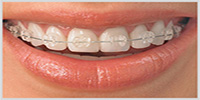
Ceramic braces are extremely popular in the present scenario. As they are translucent, they blend in with your natural tooth colour, eliminating inferiority complex and embarrassment due to braces.
B. Metal Orthodontic Braces
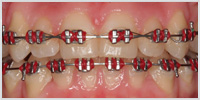
Boring braces are classic but, passé. It’s time to grace yourself with colours on your teeth. The idea is to put the colour of your choice on the metal braces for great look. Also, the results of this treatment are commendable.
C. Self Litigating Braces
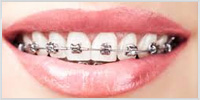
One of the most accepted and widely used brackets, Self- Litigating braces are the classic type of braces used for best results. At Spaceline Dental Studio, we specifically use the best of the brands in the dental industry- SPEED that minimizes lip and cheek irritation due to its reduced size and height along with application of continuous gentle force. Precisely, this gentle force means less discomfort and pain throughout your treatment.
2. Labial Braces
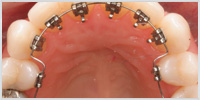
Also, known as Invisible braces, Lingual braces is another revolution in the world of dentistry. Just as the name suggests, the braces are placed behind your teeth making them invisible to other people. Usually, lingual brackets are made of metal. This is a great solution for extremely self conscious people and those with professions that demand good looks like acting, modelling etc
3.Clear Aligners
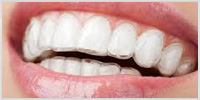
Another revolution in the world of dentistry, Clear Aligners are better defined as removable, see-through plates made of top quality, transparent plastic. The best part about them is that they aren’t visible to people and can be removed and carried anywhere when needed.
4. Jaw Growth Modification (children)

Spaceline is a reputed name in Orthodontics Growth Modification Treatment. Growth modification (early treatment) is part of the first phase of two-stage orthodontics treatment of children with malocclusion (poor bite). Growth modification is only possible when bones are still growing. Orthodontics Growth Modification Treatment is most effective during children’s growth spurts.
Orthodontists use growth modification devices (appliances) to change the position, shape, length, or width of the jawbone(s). Some common devices for the Growth Modification Treatment are:
-
- Headgear, an appliance that uses pressure to guide teeth and jaw growth
- Herbst, an appliance attached to the upper and lower molars that corrects overbites caused by a small lower jaw
- Bionator, a removable appliance that guides teeth and jaw growth
- Palatal expansion, an appliance that corrects crossbite by widening the upper jaw
5.Adult Orthodontics
Orthodontic treatments work at any age. However, they respond the best when the teeth structure is in formation mode. That’s usually after the age of 10- 16. But, we specialise in Adult Orthodontics too that specifically deals with treatments for 18+.
Many adults are concerned with the appearance of braces. At Spaceline Dental Studio, we bring to you a variety of new bracket systems including the one that is used on the inside of your teeth. This technique developed in Germany is custom made for each individual patient. There are other invisible retainer type braces that can be used to treat adults. For more severe problems, we can offer clear ceramic brackets which are aesthetically pleasing.
Benefits of Treatment in Adults
-
- Adults can benefit from orthodontic treatment in many ways. These include:
-
- Align the teeth to create a more aesthetic and beautiful smile
- Correct relapse after previous orthodontic treatment due to lack of long term retainer wear
- Improve the ability to brush and floss, especially for crowded or overlapping lower front teeth
- Create a better or more comfortable bite and ability to chew
- Address missing teeth
- Close spaces between the teeth
- Reduce excessive wear on the teeth due to grinding or poor bite jaw surgery to correct discrepancy between the upper and lower jaws.
Soreness/Discomfort
Orthodontic treatment is no more uncomfortable for adults than children. Adults undergoing orthodontic treatment report the same level of soreness as children (although adults are more willing to tell us about the soreness).
Typically, the teeth are most uncomfortable 12-24 hours after an orthodontic adjustment and will disappear within 3 to 5 days. Modern appliances are smaller and more comfortable to wear. Modern techniques with new technology put less pressure on the teeth to cause discomfort, while moving the teeth more rapidly and efficiently. It also decreases the time required between adjustments to every 8 – 10 weeks. Treatment time, on average, is completed in 18-20 months.
How Are Braces Done?
- The brackets are bonded to your teeth with composite resin
- They are exposed to light until they harden
- A metal wire applies pressure to the teeth to shift them into the desired position.
- Adjustments are made every 4-6 weeks approximately. Braces are usually worn for 12 months – 2 ½ years.
- After your braces come off you are fitted with a retainer to ensure sure your teeth don’t shift.
Maintaining Your Braces
-
- Avoid hard eatables like hard breads, apples, raw vegetables, corn cobs etc.
- Avoid sticky or chewy foods.
- Brush and floss your teeth while wearing braces, adequately.
ORTHOGNATHIC SURGERY
Corrective jaw, or orthognathic, surgery is performed by Oral and Maxillofacial Surgeons at Spaceline Dental Studio to correct a wide range of minor and major skeletal and dental irregularities, including the misalignment of jaws and teeth, which, in turn, can improve chewing, speaking and breathing. While the patient’s appearance may be dramatically enhanced as a result of their surgery, orthognathic surgery is performed to correct functional problems.
What does “orthognathic” mean?
The word “orthognathic” was coined by an oral/maxillofacial surgeon and means “straight jaws,” just as orthodontics means “straight teeth.” Prior to that time, the term surgical orthodontics or “facial orthopedics” was used to describe this medical specialty.
When is orthognathic surgery required?
Orthognathic surgery is needed when jaws do not meet correctly and/or when the teeth do not seem to fit with the jaws. The teeth are straightened with orthodontics, and corrective jaw surgery repositions the mal-aligned jaws. This not only improves the facial appearance (esthetics), but also ensures that teeth meet correctly and function properly.
Who needs orthognathic surgery?
There are many different types of abnormalities of the jaw structures that can result in facial deformity and improper bite. These abnormalities in the jaws and facial bones may be congenital (present at birth) or developed during growth and development. They may also be acquired after birth as a result of hereditary, environmental influences, or trauma/illness to the face.
It has been estimated that dentofacial (involving the teeth and face) deformities affect approximately 20 percent of the population.
Any individual with difficulty in the following areas should be evaluated for possible orthognathic surgery:
1.difficulty in chewing, biting, or swallowing
2. speech problems
3.chronic jaw or TMJ (temporomandibular joint) pain
4.open bite
5.protruding jaw
6. breathing problem
What specialists are involved in the evaluation for orthognathic surgery?
Successful orthognathic surgery requires the cooperation of many specialists, which may include the following:
Oral/maxillofacial surgeon – an orthopaedic facial surgeon responsible for treating a wide variety of dental problems, including the removal of impacted teeth and reconstructive facial surgery. This dental specialty also includes the diagnosis and treatment of diseases, injuries, and defects involving both functional and esthetic aspects of the hard and soft tissues of the oral and maxillofacial region.
Orthodontist – a specially-trained dentist who specializes in the development, prevention, and correction of irregularities of the teeth, bite, and jaws. Orthodontists also have specialized training in facial abnormalities and disorders of the jaw. A patient often consults an orthodontist after receiving a referral from his/her general dentist.
Periodontist – Periodontists are responsible for the care and prevention of gum-related diseases, guided bone regeneration, and dental implants. It is the specialty of dentistry that includes the prevention, diagnosis, and treatment of diseases of the supporting and surrounding tissues of the teeth or their substitutes, and the maintenance of the health, function, and esthetics of these structures and tissues.
Prosthodontist – Prosthodontists are dental specialists who have undergone additional training and certification in the restoration and replacement of broken teeth with crowns, bridges, or removable prosthetics (dentures). It is the branch of dentistry that also specializes in understanding the dynamics of the smile, preserving a healthy mouth, and creating tooth replacements. Prosthodontists often work closely with other members of the oral health care team in restoring natural teeth, replacing missing teeth, and/or developing artificial substitutes for damaged oral and maxillofacial tissues. In addition, prosthodontists also have specialized training in the following:
-
- post-oral cancer reconstruction
- jaw joint problems (i.e., temporomandibular joint disorder)
Endodontist- Also called pulp specialists, endodontists have undergone specialized training in performing root canal therapy. This particular branch of dentistry is concerned with the morphology, physiology, and pathology of the human dental pulp (the soft tissue between the tooth’s outer enamel and the dentin) and periradicular tissues – including the prevention and treatment of diseases and injuries of the pulp and associated periradicular conditions.
Neurosurgeon – a surgeon who specializes in the brain, spinal cord, and nerves; also coordinates all surgical interventions of head abnormalities with the craniofacial surgeons (i.e., craniosynostosis)
Ophthalmologist – a physician who specializes in the structures, functionality, and diseases of the eye. An ophthalmologist evaluates and plans treatment of associated eye problems in coordination with other surgical interventions.
Otolaryngologist (ear-nose-throat specialist) – a physician who will assist in the evaluation and management of ear infections and hearing loss that may be side effects of your child’s cleft abnormality.
Plastic/Craniofacial surgeon – a surgeon with specialized training in the diagnosis and treatment of skeletal abnormalities of the skull, facial bones, and soft tissue; will work closely with the orthodontists and other specialists to coordinate a surgical plan.
Speech and language pathologist – a professional who will perform a comprehensive speech evaluation to assess your child’s communicative abilities and who will closely monitor your child throughout all developmental stages.
At Spaceline, we bring to you the renowned names of the industry to work as a team to provide the diagnosis, treatment plan, and actual execution of the treatment.

